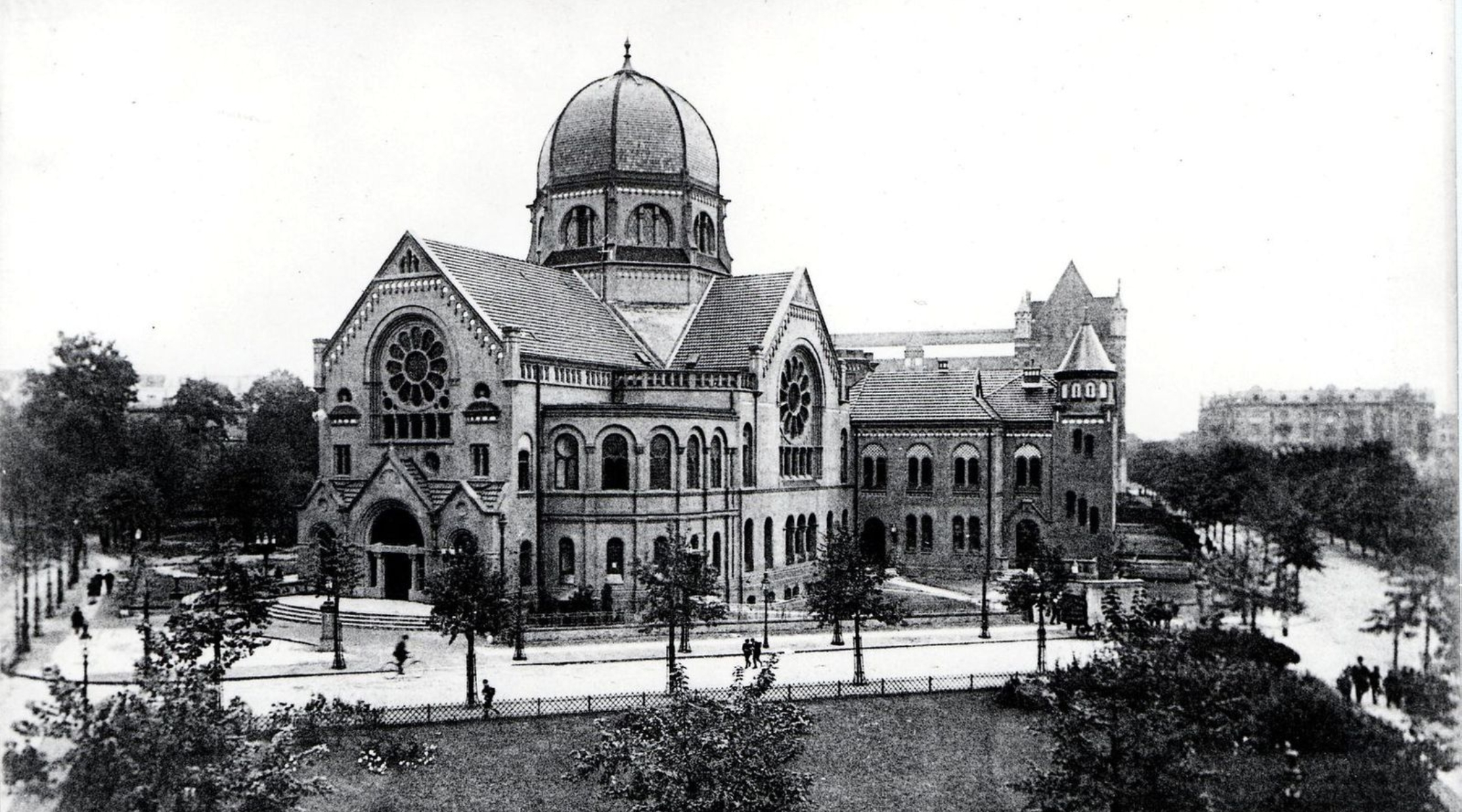85 years after Kristallnacht, Germany to begin rebuilding grand synagogue in Hamburg
‘The Bornplatz Synagogue will rise again and become a monument of remembrance, serving as the visible center for the vibrant Jewish life in our city,’ Rabbi Shlomo Bistrizky said

The Bornplatz Synagogue in Hamburg, Germany, once held 1,200 congregants before it was destroyed in Kristallnacht. (Wikimedia Commons)
(JTA) — More than 80 years after one of Germany’s most prominent synagogues was destroyed on Kristallnacht, the Jewish community of Hamburg has taken ownership of the building’s site and is set to begin rebuilding it.
The site of the Bornplatz Synagogue, a neo-Romanesque building dedicated in 1906 that had a 1,200-seat sanctuary and was once the largest synagogue in northern Germany, was officially handed over to leaders of the city’s Jewish community on Wednesday. At the ceremony marking that restitution, officials from the city of Hamburg cut up a copy of the Nazi-era Aryanization document that ordered the demolition of the synagogue.
“We apologize for coming to the decision so late to give them back their property,” Dirk Kienscherf, a local official from the center-left Social Democratic Party, said to representatives of the Jewish community at the ceremony.
The synagogue was burned during Kristallnacht, the series of pogroms in 1938 when Nazis destroyed synagogues and Jewish-owned stores across Germany. Its remains were later forcibly sold to the city and demolished, and an air raid bunker, for use only by Aryans, was built next door. At present, the empty site features a mosaic outlining the synagogue’s architecture, including its vaulted ceilings, that was laid in 1988 by artist Margrit Kahl.
“The Bornplatz Synagogue will rise again and become a monument of remembrance, serving as the visible center for the vibrant Jewish life in our city,” Rabbi Shlomo Bistrizky, a Chabad-Lubavitch movement emissary and chief rabbi of Hamburg, said in a statement.
The quest to rebuild the synagogue, more than eight decades after its destruction, began in the shop of a local antique dealer in the summer of 2020. Daniel Sheffer, an Israeli-born entrepreneur now based in Hamburg, was in the shop when he discovered a silver Torah crown engraved with a dedication to Markus Hirsch, the first rabbi of the Bornplatz Synagogue — which left him feeling “overwhelmed,” he told the Jewish Chronicle.
“But I also felt embarrassed and ashamed and angry, because I was being asked to buy back what was stolen from my ancestors,” he added. “That feeling lasted for days.”
Sheffer eventually bought the crown and brought it with him to more than 50 meetings with public officials and other potential supporters of his campaign, titled “No to antisemitism. Yes to the Bornplatz Synagogue.”
That effort led to the formation of the Initiative for the Reconstruction of the Bornplatz Synagogue, which Sheffer leads. The project secured more than $600,000 in German government funding to conduct a study evaluating the feasibility of rebuilding the synagogue. The construction itself will be funded by the Hamburg municipal government, the German government and private donations.
The pledges of public support for the project came following two more recent attacks on Jews in Germany: the 2019 shooting at a synagogue in the city of Halle, and an attack almost exactly a year later at the Hohe Weide synagogue in Hamburg during Sukkot, in which a Jewish student was seriously injured.
The Torah crown Sheffer bought is now housed at Hohe Weide synagogue. One of the Torah scrolls from the Bornplatz Synagogue, meanwhile, found its way to the United States in 1940 via Italy, rescued by a congregant, Joseph Bamberger. The Torah scroll continued to be used in the synagogues Bamberger and his family attended in Manhattan, and as of 2021, it is in the permanent collection of the city’s Museum of Jewish Heritage.
Some have argued that rebuilding the synagogue would lead the public to forget the atrocities of the Holocaust, while memorials like the one that currently exists in the square are a reminder of the community’s loss and destruction. “The mosaic communicates and commemorates the open wound of the building’s absence, and through it, the absence of what was once one of Western Europe’s most thriving Jewish communities,” Galit Noga-Banai wrote in Haaretz criticizing the reconstruction initiative.
Because of the unusual way the synagogue was destroyed — all of its rubble was pushed into the basement — some surprises have turned up during the excavation process. Those include colorful glass shards from the synagogue’s windows, which give a sense of what the building — whose image has been preserved in black-and-white photos — looked like, Northern German Broadcasting reported.
When the excavation is completed, an architectural competition for the design of the new synagogue will be held, and the bunker standing next to the synagogue will be demolished.
“This moment today is a turning point for our Jewish history in Hamburg,” Sheffer said, according to a local radio station. “It is the victory of justice and Jewish life in Hamburg over the barbarism of the Nazis.”
This article originally appeared on JTA.org.















